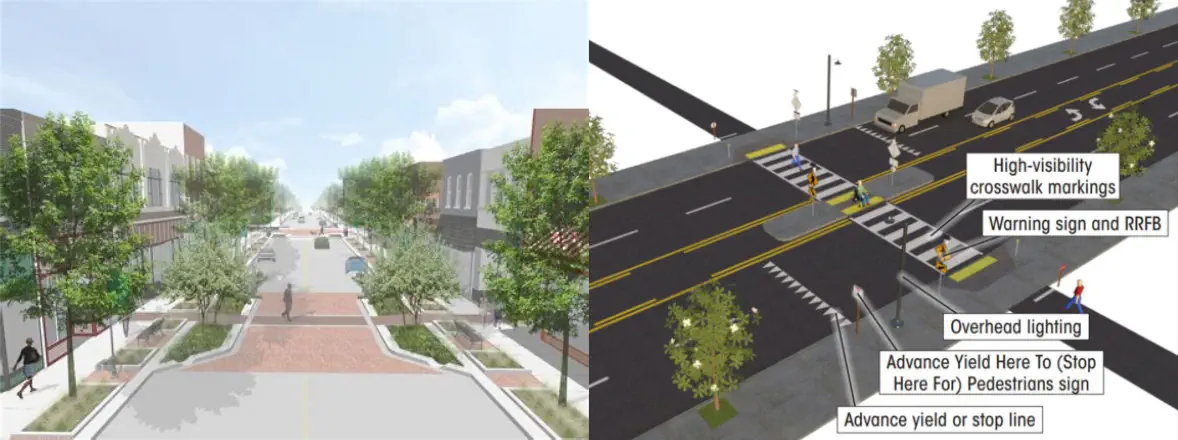Re: Safety Committee Followup - Mid Block Crossing at N. Main St.
Hi ████,
Thanks for getting in touch. I know this is an important topic for you and I’m happy to provide an update and share my own thoughts.
The Safety Committee has met every month since November 2024 (except for a spring break in March) and will meet again on June 23 at 6:30 pm. Our main focus during this time has been reviewing the Downtown Traffic and Safety Study prepared by the village engineer. Our purpose is to arrive at a set of specific recommendations – including anything from crosswalk markings to traffic pattern changes to entirely new signal equipment – to be presented to council and, in turn, the village administration. Our immediate focus is on those changes that can be implemented in conjunction with the repaving of downtown that will occur when the bridge project is complete in early 2026.
The mid-block crosswalks to Triangle Park on Main and Franklin have been a committee priority and the subject of much discussion. I expect that at the June meeting we will finalize a list of recommendations that includes improved pavement markings, new painted yield lines 20′ in advance of the crosswalks, permanently removed parking spaces for improved visibility, and curb extensions at all four entrances. This will bring the curb ramp out to the edge of the parking lane, as well as prevent vehicles from stopping illegally in or too close to the crosswalk and blocking the view. You can see the preliminary plans in Chagrin Falls Downtown Safety Exhibits (p. 4).
As for Rectangular Rapid Flashing Beacons (RRFB), I do not think they are the quick fix you imagine. For starters all three uncontrolled crosswalks (the mid-blocks on Main and Franklin, and the brick crosswalk at River Street) pass through parking lanes on both sides of the street, meaning an RRFB would need to be located on the sidewalk – separated from traffic lanes by 12-14 feet. That kind of configuration may be possible, but I have never seen it in person and could find no examples of it online. All of the RRFB manufacturers and MUTCD installation guidance I found indicated that the RRFB poles should be located immediately adjacent to to the lane of travel, either where no parking lane exists (as on the Orange and Solon Road installations) or a curb extension has been created (as on Main Street in Hudson, for example). So the first step is to create those curb extensions, as I hope we do.
However – and I’m speaking strictly for myself here – I still do not support RRFBs as a solution at these locations. I’ve seen some of the studies you mention and I acknowledge that RRFBs can be effective. But even FHWA’s publication points out that “yielding rates as low as 19 percent have also been noted.” Context seems to be the main driver of their effectiveness, with the sweet spot being 35 MPH roads with infrequent cross-streets/intersections. Drivers there have a reasonable expectation that they can proceed uninterrupted, so using RRFBs to warn them well in advance of a person in the crosswalk makes perfect sense. So I have no issue with the ones on Solon Road or Bell Street at South Russell Village Park.
But in downtown Chagrin – with 25 MPH limits and frequent cross streets and signalized intersections – I’d rather see countermeasures that encourage drivers to slow down and proceed with caution at all times, like high-visibility crosswalk markings, daylighting, curb extensions, lane reductions, and pedestrian refuges. FHWA’s Guide for Improving Pedestrian Safety at Uncontrolled Crossing Locations (p. 16) places RRFBs after all of these countermeasures for 25 MPH streets with our traffic volume (less than 9,000 average daily).
In a built-up environment like downtown Chagrin, I think RRFBs and more signage would just blend in to the visual noise of streetlights, traffic signals, shops and restaurants. Anecdotally, on Orange Street at West I’ve watched car after car after car just breeze through the flashing signs with people waiting on the curb for a break in traffic. I don’t feel any more safe crossing there than I do at the triangle.
I’ll admit that my position mostly just comes down to a different philosophical choice. For decades U.S. street design has been (mistakenly, I would argue) influenced by interstate highway design, with an emphasis on high speeds and limited interruptions for vehicular traffic at the expense of anyone not in a car. To me, RRFBs look like a product of that mindset, using signage and lights and buttons to prioritize cars over people. Thankfully in recent years a new, equally valid and more equitable approach with an emphasis on all forms of movement has gained traction and demonstrated great success, making better use of the available space with curbs and green space to calm traffic and separate cars from people. On the spectrum of street designs represented by the first and second images below, I’ll choose the first option for Chagrin every time. But that’s just my position. If enough members of council or the administration can be convinced RRFBs could be installed.
Thanks again for your feedback and feel free to follow up with any additional questions or comments.
